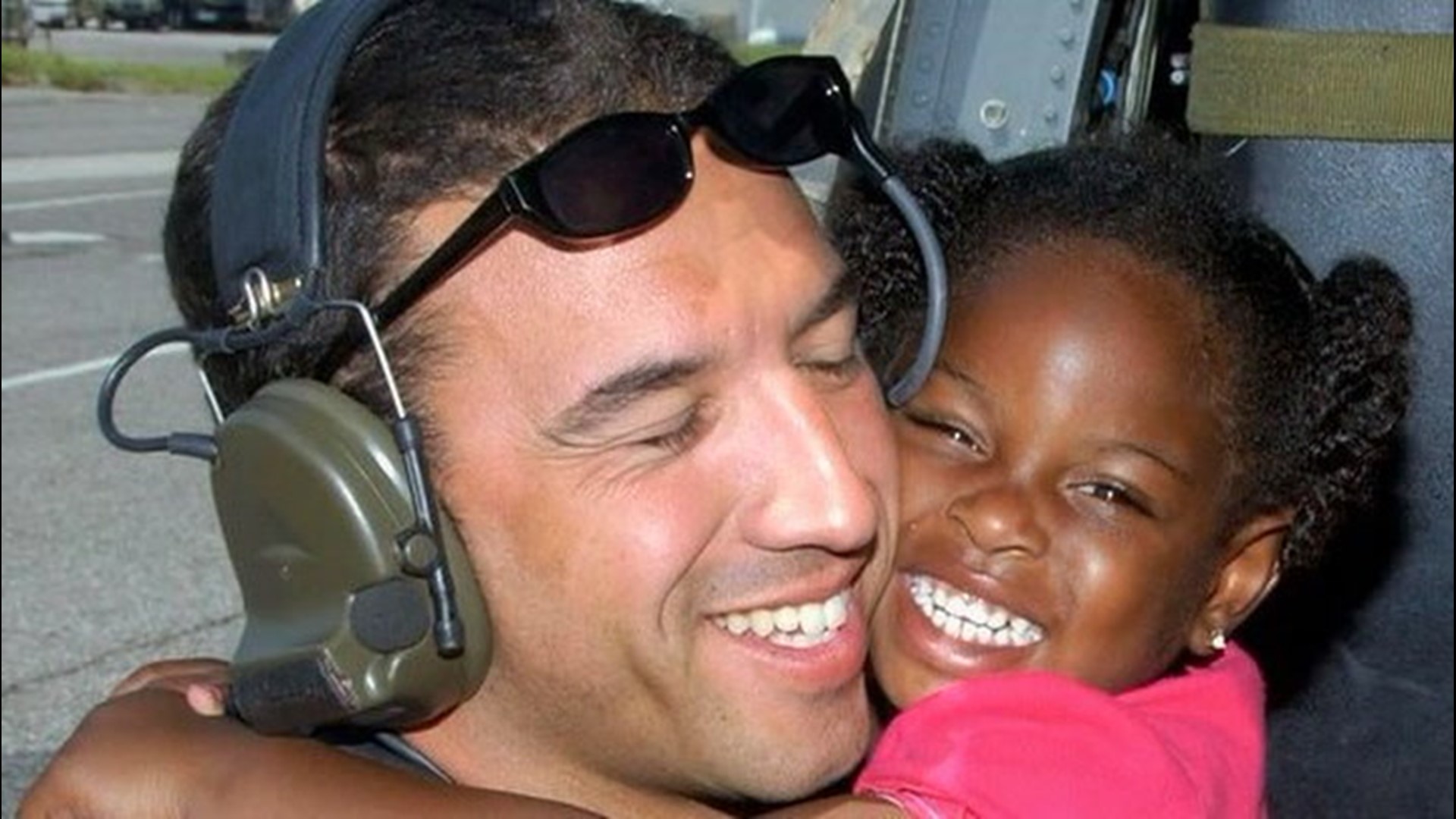By the sixth day, the weight of the rescues and the destruction was beginning to build for Staff Sgt. Mike Maroney, a pararescueman from the 58th Rescue Squadron at Nellis Air Force Base, Nevada, at the time.
Hurricane Katrina had wrought destruction across the coast of Louisiana and parts of Mississippi to a magnitude never seen before in the states' histories -- and the effects of Katrina's infamy on the people reverberated across the nation.
"It was sad and it was hard," Maroney recently told AccuWeather over a Zoom call. Discussing the nature of his job, he said, "I get to go rescue people in war, in civilian [emergencies], in wherever, whatever ... I get to go help them. But it never changes. When you see somebody who's sad and hurt and just scared and they don't know what's going on, and you can't help but feel their pain."
The pararescuemen were able to return to a Motel 6 in Jacksonville, Mississippi, each night. They slept in beds and enjoyed the luxury of air conditioning while recharging for the next day's mission, but Maroney was all too aware of what remained only an hour away by helicopter.
"You don't let it bother you while you're working," Maroney said. "But once you're done, then you go home ... you sit down and you're grateful for what you got."
But he wasn't home yet, and his job still wasn't finished. On the morning of the sixth day, his team traveled the hour south to reach New Orleans once more. The rescues seemed to emphasize how much, even six days after landfall, people still needed help.

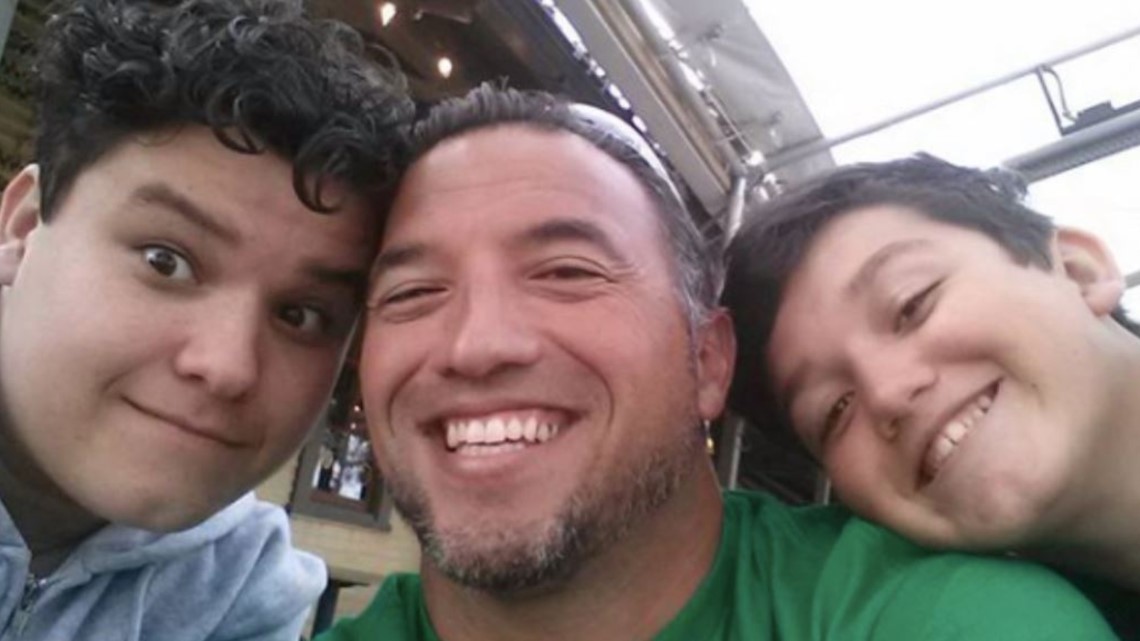
The team picked up a man who was suffering a heart attack and later a woman who was in a coma. A neighbor had been one, if not the only, person who knew the woman was still in her home and directed the rescue teams to her during what Maroney described as "a rough morning."
"In my head, I'm going, 'How many other people are having heart attacks? How many other people are out there and we're not helping them,' and I can feel the weight of every single one of them," he recalled.
His next rescue, however, would ease the weight with a simple, warm gesture.
Maroney was no stranger to plunging into the aftermath of disasters, from responding to the destruction caused by a super typhoon in Mozambique in 2000 to flooding in Las Vegas. However, seeing New Orleans after Katrina struck a chord in him.
He had visited New Orleans before Katrina for paramedic rotations and was familiar with the city and some of its people. He had made friends in the city and eaten at the restaurants.
"It's sad to see any place destroyed," Maroney said, adding that New Orleans had by then taken on a "kinda home-ish" characteristic in his life. To be witnessing the city post-Katrina, Maroney said, "hurts even worse."
Even with the destruction in Mozambique, which Maroney described as the "worst one" in terms of disaster rescues in recent history that he had been sent to, the catastrophe was different compared to the kind Katrina had unleashed upon New Orleans.
"Everything was on fire or under water and/or both," Maroney said of the chaos that overwhelmed the city. "Houses got pushed off their foundation, so then the gas line is leaking and so fire's spraying into the air, so everything's on fire."
Before the storm hit, Maroney had just returned from a deployment in Kandahar, Afghanistan. He remembered watching the storm "the size of the Gulf" approach the city.
"I've been to war, I've been to typhoons, I've seen things," Maroney said. "And you know, every time you see it, it's like a new, 'Wow, I did not think that destruction could be this much.'"
Fifteen years later, Katrina remains the costliest storm to have made landfall in the United States. The storm made its first landfall over Florida, striking the state as a Category 1 hurricane. Although Katrina weakened into a tropical storm over the land, the warmer waters of the Gulf of Mexico fueled Katrina into a monstrous Category 5 hurricane. At its strongest point, Katrina's maximum sustained winds reached 175 mph. To reach Category 5 status, the maximum sustained winds need to reach 157 mph.
Katrina made landfall near Buras, Louisiana, just after 6 a.m. CDT, on Aug. 28, with maximum sustained winds of 125 mph -- making landfall as a strong Category 3 hurricane. The storm made an additional landfall near the Louisiana-Mississippi border around 9:45 a.m. CDT the same day, retaining its Category 3 status with 120-mph sustained winds.
The infamous storm, its name now retired by the National Hurricane Center, is reportedly responsible for about 1,200 deaths, the majority in Louisiana.
Although the storm didn't hit the state at its full force, the intensity and storm surge from Katrina was enough to cause catastrophic damage to parts of southern Mississippi and southeastern Louisiana, including New Orleans. The storm surge overtopped and breeched the levees in the New Orleans metropolitan area, inundating a majority of the city -- which already sat below sea level -- and its eastern suburbs.
"And then when we flew down the rest of the Gulf Coast towards like Keesler, it looked like God just went -- " Maroney swept his arm across the screen, with a whooshing sound effect -- "and just wiped everything clean for a mile up the beach. And then at the mile up was all the debris; everything was like matchsticks."
Closer to the ground, more hazards to the survivors loomed -- much of them in the water.
Maroney recalled the deepest parts of the lingering, contaminated surge being anywhere from 10 to 14 feet in the first few days, trapping people in trees and on buildings in some areas.
During one rescue operation in the city on his fourth or fifth day, Maroney was lowered down from the helicopter into a school playground where hundreds of people had crowded, seeking dry ground.
"Hey, I want out of here," one man called to the pararescueman.
"Are you a man?" Maroney responded.
"Yeah."
"Alright, well help me get the older people, the women, the people that need help, help me get them out of here first, and then I'll get you out of here."
And he did, going through the crowd, triaging people and lining them all up.
"The guy was scared, you know. But as soon as I gave him something to do, he took control," Maroney said. "I love that guy."
Time after time, Maroney and his team returned, and the man remained, still assisting in rescuing others. The number of people remaining began to dwindle. By the sixth time Maroney's team returned, everyone had been picked up, including the man.
Sometime during the chaos, Maroney had managed to get a selfie with the man. Although he spent time after the hurricane looking for the man, he had no luck in finding him again.

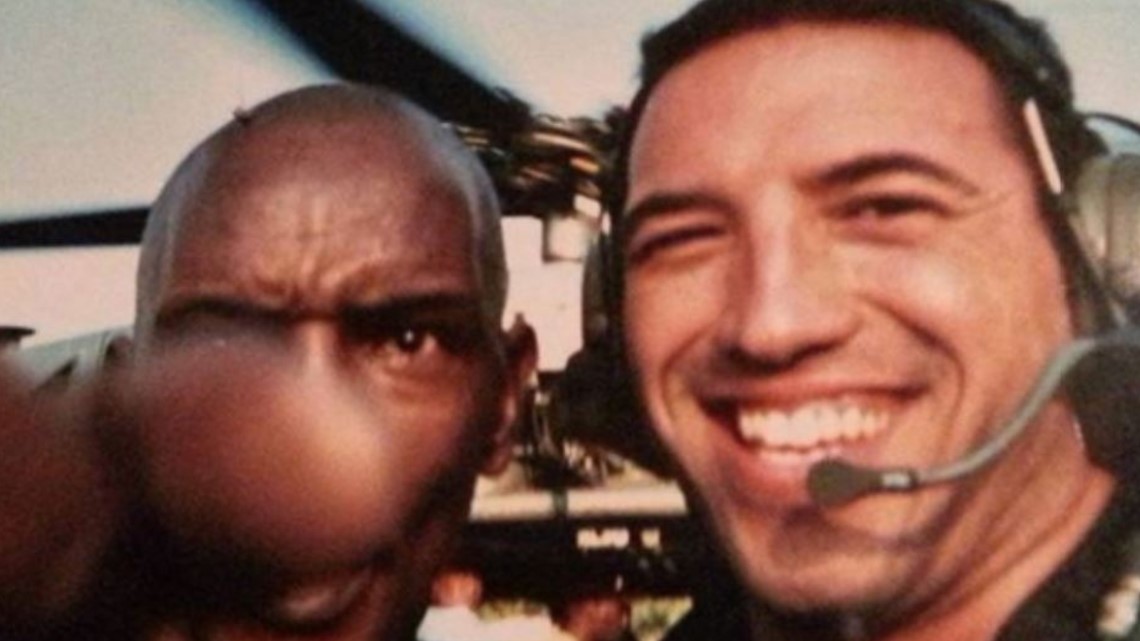
On the sixth day, after dropping off the woman in a coma, Maroney and his colleagues were flying near the Superdome when they spotted a family in the water. By then, the surge had receded to about just above waist-level, Maroney recalled.
He had his team lower him down to speak with the family. They had been in their apartment for the six days following Katrina.
With them was a girl about the size of Maroney's son, who was 3 at the time.
"Would you like to go on a helicopter ride?" he asked her, to which he received a resounding "Yes!" in response.
"I wrapped the strap around her a bunch of times because, you know, [a] 3-year-old kid, [is] real small versus your average human, so I'm hanging onto her tight," Maroney said.
Far above the city, the girl looked out across the panoramic view, pointing out places like her home, her school and her church. And when the girl's mom began to cry on the helicopter with the rest of their family, the girl went over and started rubbing her back.
"It's okay, Mom. We're safe now," Maroney heard her say to her mother.
When they landed at Louis Armstrong New Orleans International Airport, Maroney went to take the girl off the helicopter when she wrapped him up in a sudden hug.
"And I just, my stomach didn't hurt, my heart didn't hurt, my head didn't hurt. Nothing hurt," Maroney said. Unbeknownst to him, another member of the Air Force snapped a photo, capturing the heartwarming moment.

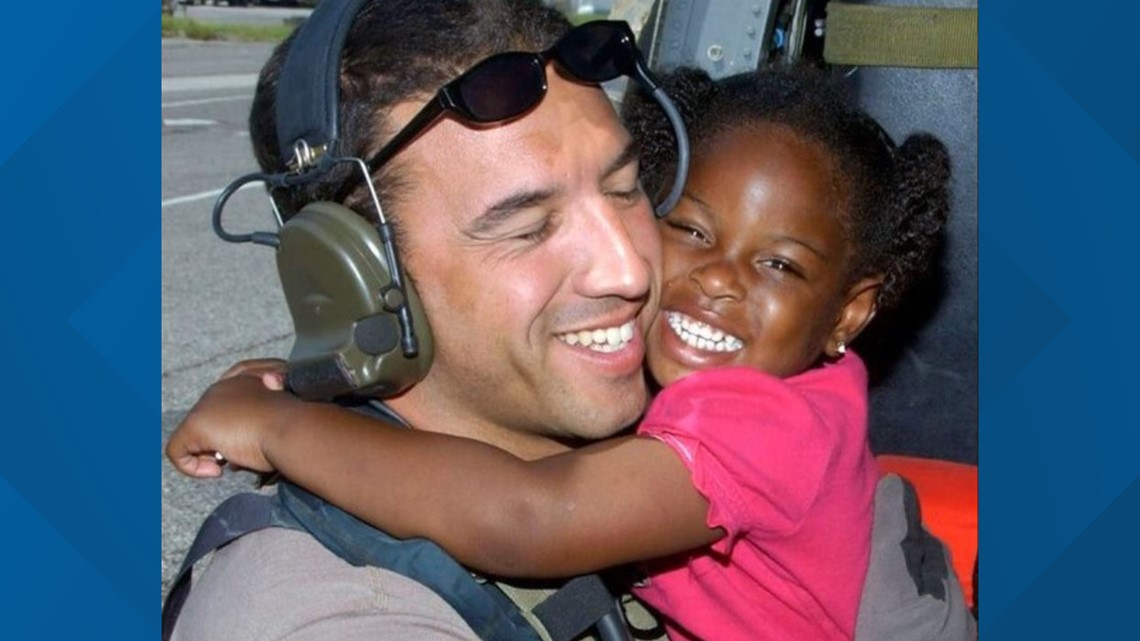
"I believe I fill my cup up when I can, and I fill other people's cups up when I can," Maroney said. "My cup was dangerously low that day, and a little girl, you know, [who] suffered through a storm, came and gave me a hug and gave me the strength that I needed and keep on going."
Five or so years after Katrina, Maroney started to wonder what had become of the people he'd rescued in the immediate aftermath of the storm. He didn't have photos of everyone, but he had a few, including the one of the girl and then the man who had helped evacuate the large group of people.
He wasn't able to find the man, but the hashtag #FindKatrinaGirl began to circulate over social media, which by then was becoming a sensation. After the help of a person with a large following who Maroney just referred to only as "Andrew," he was reconnected with the family he had saved.
After speaking with her mom, Maroney reunited with the girl, LaShay Brown, in 2015 -- 10 years after Hurricane Katrina. Brown declined an interview with AccuWeather.
To this day, Maroney keeps in contact with the Brown family, and he inspired Brown to join the Junior Reserve Officer Training Corps (JROTC), according to People magazine.

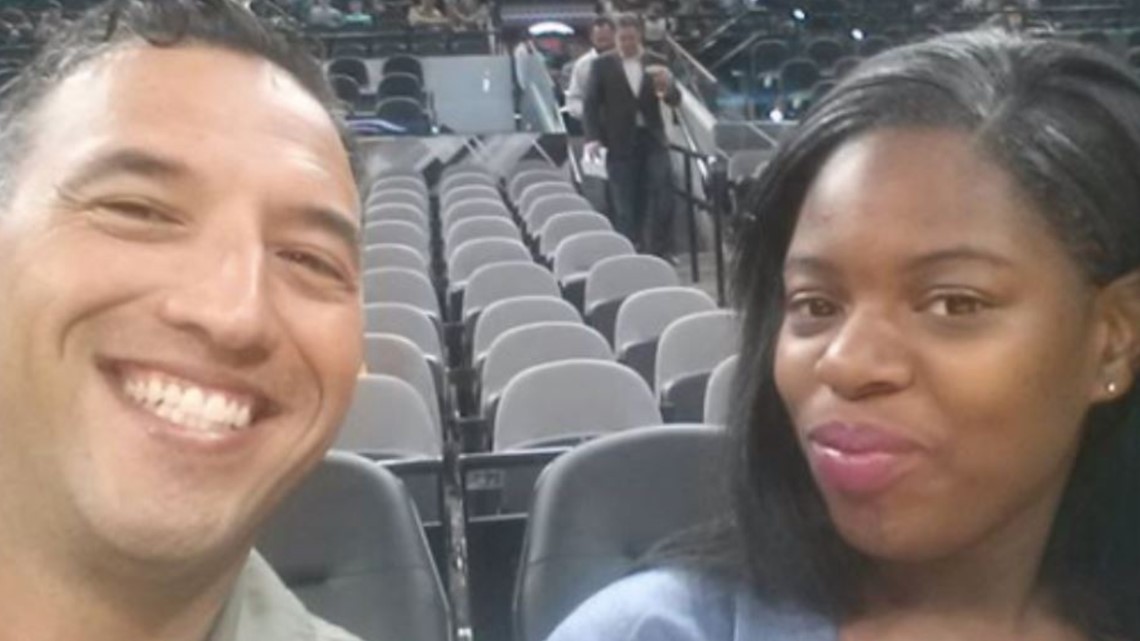
Maroney, having retired from the Air Force in 2017 and about to retire from civil service, still devotes his time to helping people. He trains people on the side to prepare them for pararescue or to be rescue swimmers with the U.S. Coast Guard at Cone Fit, LLC. He also co-owns the non-profit Waves of Change Performance Institute where he helps vets repurpose themselves and connects them as mentors with younger people he trains.
The photo, however, still reminds him of how someone rescued after Katrina in turn helped him.
"What they did for me was so much more than anything I ever did for them," Maroney said.

